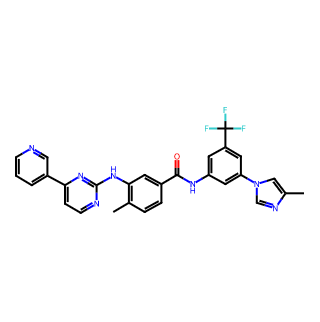- Synthetic anti-infective drugs
- Medications for the digestive system
- Antipyretic and analgesic drugs
- Medications for the blood system
- Medications for the respiratory system
- Anti-allergic drugs
- Medications for the urinary system
- Diagnostic medications
- Immunosuppressive and immunomodulatory drugs
- Vitamins and mineral supplements
- Antioxidants and medications for osteoporosis
- Antiparasitic drugs
- Ophthalmic medications
- Amino acids and their derivatives
- Dermatological medications
- Medications for the circulatory system
- Antitumor drugs
- Medications for the nervous system
- Hormonal and endocrine function-regulating drugs
- Antibiotics
- Others
CAS Number: 641571-10-0




Basic Information
Product Name: Nilotinib
CAS Number: 641571-10-0
Chemical Formula: C28H22F3N7O
Molecular Weight: 529.52 g/mol (or 529.51600 g/mol with higher precision)
Physical Properties
Appearance: Nilotinib is a grayish-white solid.
Density: 1.36 g/cm³
Refractive Index: 1.65
Melting Point: Not specifically mentioned, but it is a solid at room temperature.
Solubility: Solubility information is not provided, but it is likely to be soluble in certain organic solvents.
Chemical Properties
Structure: Nilotinib has a specific chemical structure with a molecular formula of C28H22F3N7O.
Mechanism of Action: Nilotinib is a high-affinity ATP-competitive inhibitor based on aminopyrimidine. It selectively inhibits Bcr-Abl autophosphorylation and reduces the proliferation and developmental ability of wild-type Bcr-Abl and imatinib-resistant mutant cells.
Biological Activity
Antitumor Activity: Nilotinib is an orally available Bcr-Abl tyrosine kinase inhibitor with antineoplastic activity. It is effective in the treatment of chronic myeloid leukemia (CML) patients who are resistant or intolerant to imatinib.
Pharmacodynamics: After oral administration, nilotinib is absorbed into the bloodstream and distributed to tissues. It inhibits the activity of Bcr-Abl tyrosine kinase, thereby inhibiting the proliferation of leukemic cells and inducing their apoptosis.
Applications
Therapeutic Use: Nilotinib is used for the treatment of patients with CML who are resistant or intolerant to imatinib.
Research Use: It is also used in scientific research to study its mechanisms of action, antitumor activity, and interactions with other drugs or biological systems.

Tai Yau Street, San Po Kong, Kowloon, Hong Kong, China.



